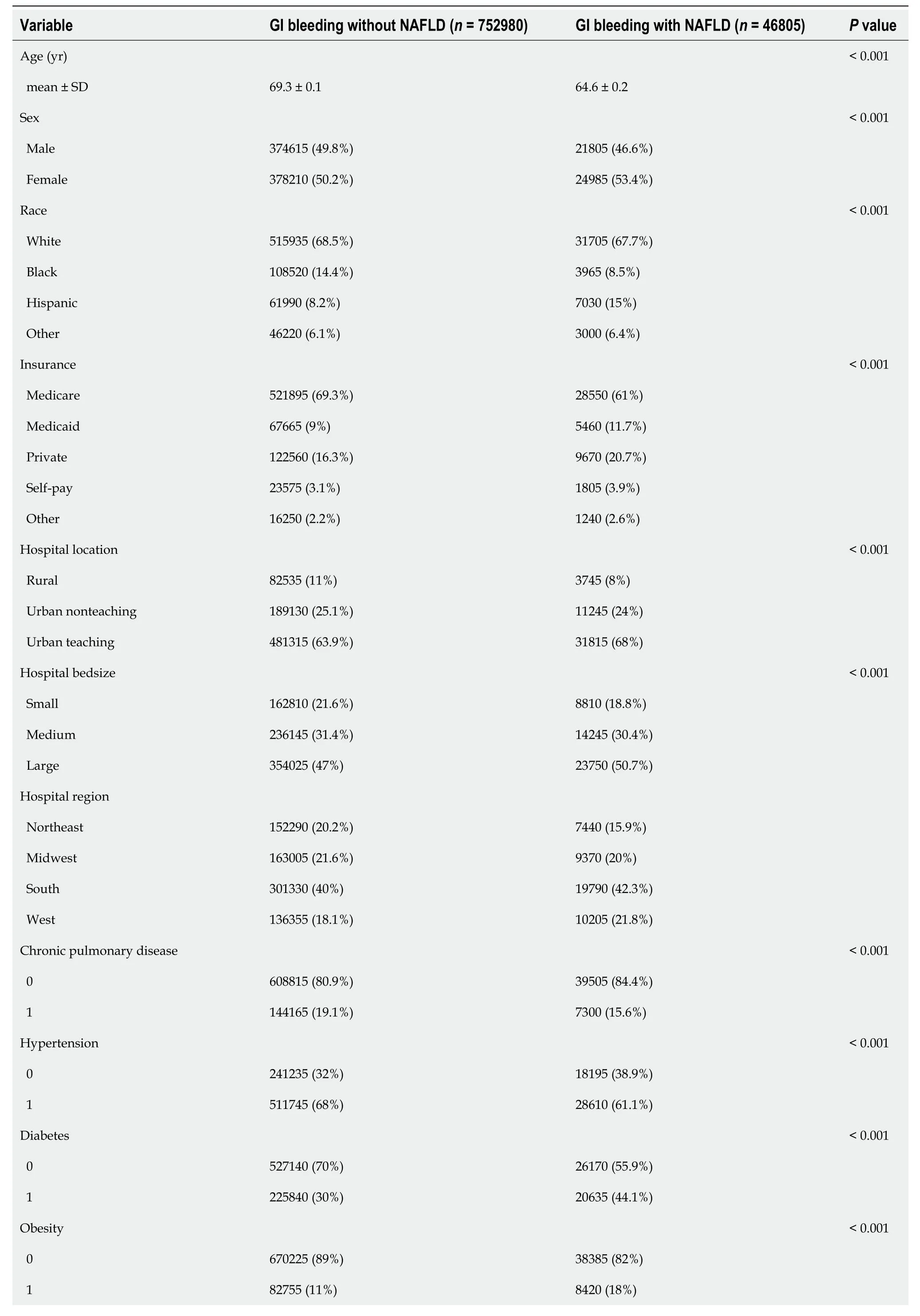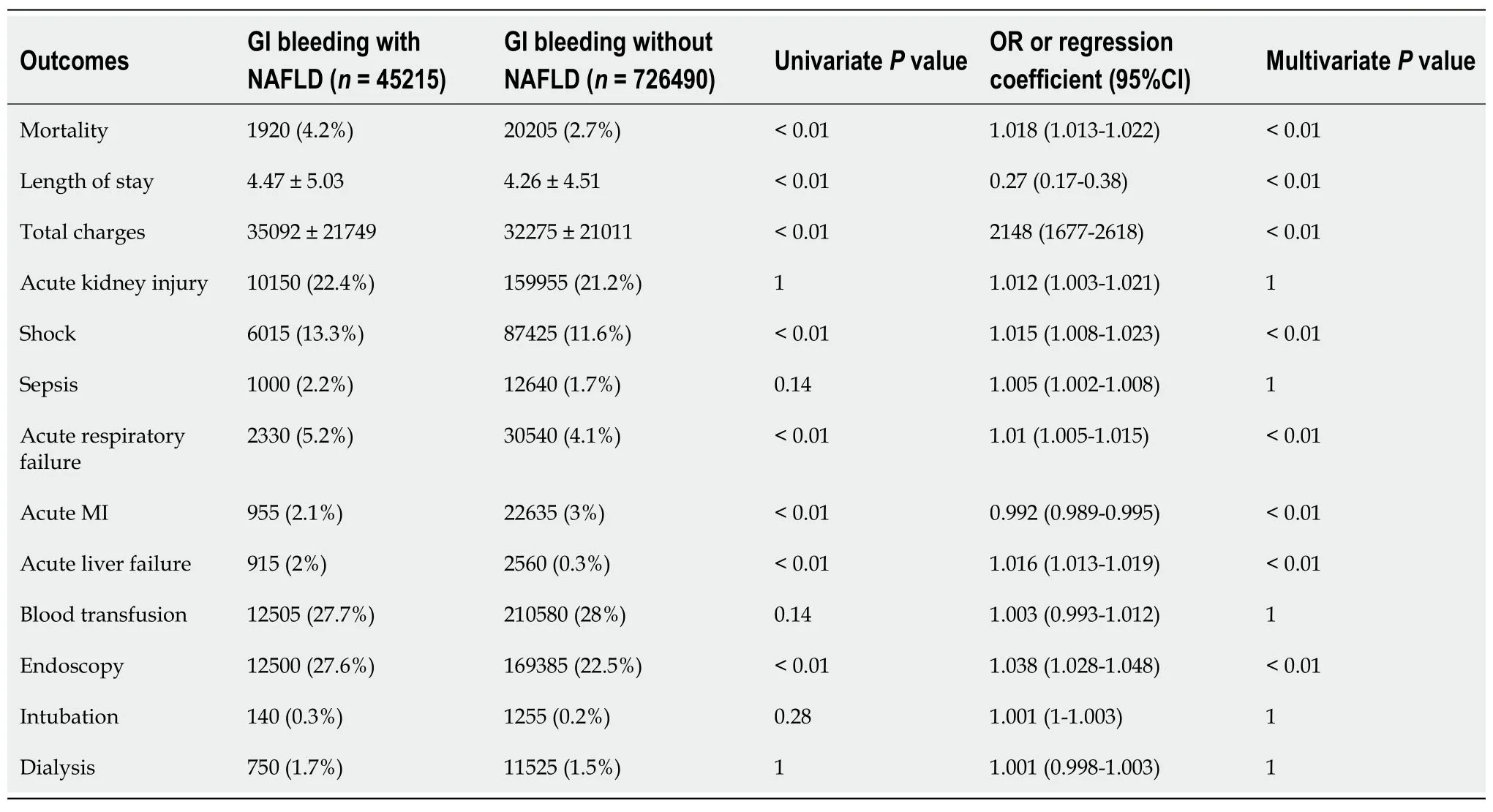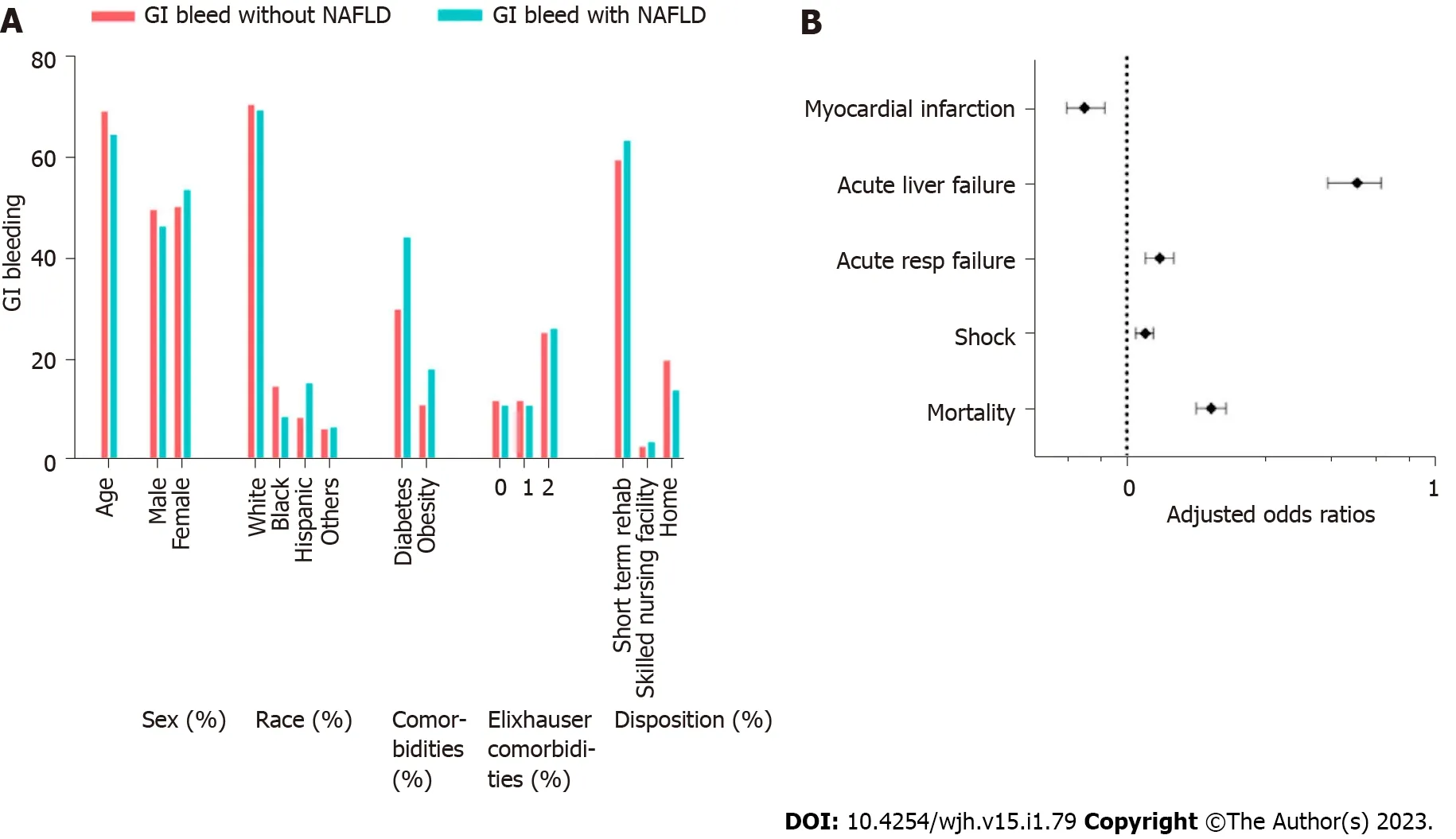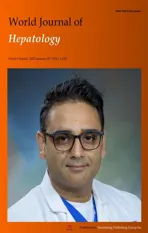Influence of non-alcoholic fatty liver disease on non-variceal upper gastrointestinal bleeding: A nationwide analysis
2023-03-18AakritiSoniAnuroopYekulaYuvarajSinghNitishSoodDushyantSinghDahiyaKannuBansalGMAbraham
Aakriti Soni,Anuroop Yekula,Yuvaraj Singh,Nitish Sood,Dushyant Singh Dahiya,Kannu Bansal,GM Abraham
Aakriti Soni,Anuroop Yekula,Yuvaraj Singh,Kannu Bansal,GM Abraham,Department of Internal Medicine,Saint Vincent Hospital,Worcester,MA 01608,United States
Nitish Sood,Department of Internal Medicine,Medical College of Georgia,Augusta University,Augusta,GA 30912,United States
Dushyant Singh Dahiya,Department of Internal Medicine,Central Michigan University,Saginaw,MI 48602,United States
Abstract BACKGROUND Non-alcoholic fatty liver disease (NAFLD) is the leading cause of liver disease globally with an estimated prevalence of 25%,with the clinical and economic burden expected to continue to increase.In the United States,non-variceal upper gastrointestinal bleeding (NVUGIB) has an estimated incidence of 61-78 cases per 100000 people with a mortality rate of 2%-15% based on co-morbidity burden.AIM To identify the outcomes of NVUGIB in NAFLD hospitalizations in the United States.METHODS We utilized the National Inpatient Sample from 2016-2019 to identify all NVUGIB hospitalizations in the United States.This population was divided based on the presence and absence of NAFLD.Hospitalization characteristics,outcomes and complications were compared.RESULTS The total number of hospitalizations for NVUGIB was 799785,of which 6% were found to have NAFLD.NAFLD and GIB was,on average,more common in younger patients,females,and Hispanics than GIB without NAFLD.Interestingly,GIB was less common amongst blacks with NAFLD.Multivariate logistic regression analysis was conducted,controlling for the multiple covariates.The primary outcome of interest,mortality,was found to be significantly higher in patients with NAFLD and GIB [adjusted odds ratio (aOR) = 1.018 (1.013-1.022)].Secondary outcomes of interest,shock [aOR= 1.015 (1.008-1.022)],acute respiratory failure [aOR = 1.01 (1.005-1.015)] and acute liver failure[aOR = 1.016 (1.013-1.019)] were all more likely to occur in this cohort.Patients with NAFLD were also more likely to incur higher total hospital charges (THC) [$2148 ($1677-$2618)];however,were less likely to have a longer length of stay [0.27 d (0.17-0.38)].Interestingly,in our study,the patients with NAFLD were less likely to suffer from acute myocardial infarction [aOR = 0.992 (0.989-0.995)].Patients with NAFLD were not more likely to suffer acute kidney injury,sepsis,blood transfusion,intubation,or dialysis.CONCLUSION NVUGIB in NAFLD hospitalizations had higher inpatient mortality,THC,and complications such as shock,acute respiratory failure,and acute liver failure compared to those without NAFLD.
Key Words: Non-alcoholic fatty liver disease;Non-variceal gastrointestinal bleeding;Outcomes;Mortality;Complications
INTRODUCTION
Non-alcoholic fatty liver disease (NAFLD) is a common cause of chronic liver disease worldwide[1].It has a disease spectrum ranging from hepatic steatosis to non-alcoholic steatohepatitis,which may ultimately lead to liver cirrhosis[2].Major risk factors for NAFLD include obesity,metabolic syndrome,diabetes mellitus,hypertriglyceridemia,hypertension,and increasing age.The primary pathophysiological mechanism implicated in the development of NAFLD involvesde-novosynthesis and uptake of triglyceride by hepatocytes leading to the development of ‘fatty liver’[3].Per current literature,NAFLD is associated with significant morbidity and all-cause mortality,with mortality rates ranging from 5% to 40%[4-6].Furthermore,with increasing rates of NAFLD in the global population,associated complications such as gastrointestinal bleeding (GIB) are also on the rise.
Upper GIB can be divided into 2 main categories,namely variceal and non-variceal upper GIB(NVUGIB).Variceal GIB is usually seen in patients with portal hypertension in a setting of underlying liver cirrhosis[7,8].However,the most common cause of NVUGIB is peptic ulcer disease.Other causes include but are not limited to gastritis,duodenitis,angiodysplasia,non-variceal esophageal hemorrhage secondary to mucosal tears,etc.All the causes included in the study are mentioned in the Supplementary material,malignancy as a cause of NVUGIB was not included in the study.In the United States,it is estimated that NVUGIB has an incidence rate of 61-78 cases per 100000 persons with a mortality rate ranging from 2%-15% depending on the co-morbidity burden.Although there is a significant paucity of data on the rates of NVUGIB in NAFLD populations,current literature has described a positive association betweenHelicobacter pylori(H.pylori) infection and NAFLD,which could in turn lead to higher rates of GIB.Hence,in this study,we investigate and compare hospitalization characteristics,clinical outcomes,and complications of NVUGIB in NAFLD and non-NAFLD hospitalizations in the United States.
MATERIALS AND METHODS
Study design and data source
The study population was derived from the National Inpatient Sample (NIS) which is a part of the Healthcare Cost and Utilization Project (HCUP) databases.It is one of the largest publicly available,multi-ethnic databases derived from a collection of billing data submitted by United States hospitals to state-wide data organizations.As the NIS collects data from almost all hospitals across the United States,it covers greater than 95% of the United States population.It approximates a 20% stratified sample of discharges from United States community hospitals and the dataset is further weighted to obtain national estimates.For our study period between 2016 and 2019,the NIS database was coded using the International Classification of Diseases,Tenth Clinical Modification/Procedure Coding System (ICD/PCS-10).
Study population
We identified all adult (≥ 18 years) hospitalizations with NVUGIB in the United States from 2016-2019.The study population was further divided into two distinct subgroups based on the presence or absence of NAFLD.Individuals ≤ 18 years of age,and those with a diagnosis of liver disease other than NAFLD were excluded from the analysis.Details on inclusion and exclusion criteria are included in the Supplementary material.
Outcome measures
The primary outcome of interest was mortality.Secondary outcomes of interest included length of stay(LOS),hospital charges,and complications such as acute kidney injury,shock,sepsis,acute respiratory failure,acute myocardial infarction,acute liver failure,blood transfusion,need for early endoscopy,need for intubation,and need for dialysis.
Ethical considerations
The NIS does not contain patient or hospital-specific identifiers.Hence,an Institutional Review Board(IRB) approval was not required for this study as per the guidelines put forth by our IRB on the analysis of HCUP databases.
Statistical analysis
The statistical analysis was conducted using R software (version 4.2.1) to account for weights in the stratified survey design for the NIS database.The weights were considered during the statistical estimation process by incorporating variables for strata,clusters,and weights for discharges in the NIS database.Descriptive statistics were provided,including the mean (standard error) for continuous variables and count (percentage) for categorical variables.Mann-Whitney tests with Bonferroni corrections were used for testing differences in continuous variables,while chi-squared tests with Bonferroni corrections were used for testing the homogeneity of categorical variables.Furthermore,a multivariate regression analysis was performed to compare outcomes such as in-patient mortality,healthcare burden (mean LOS and mean total hospital charges),and complications.All analyses withPvalues ≤ 0.05 were considered statistically significant.
RESULTS
Hospitalization characteristics
We identified a total of 799785 patients admitted with a primary diagnosis of NVUGIB between the years 2016 and 2019 that met our inclusion criteria.Of these 752980 (94.15%) belonged to the cohort without NAFLD and 46805 (5.85%) belonged to the cohort with NAFLD.
Compared to the group without NAFLD,the patients with NAFLD were significantly younger (69.3vs64.6,P<0.001).In both groups,GIB was more common in females.Furthermore,there were statistically significant racial differences noted,with GIB and NAFLD being less common in blacks (8.5%vs14.4%,P<0.001) and more common in Hispanics (15%vs8.2%,P<0.001).The Elixhauser comorbidities index was almost similar in both groups,with most patients having 2 or more comorbidities.Compared to the group without NAFLD,we noted that the NAFLD group had a higher proportion of patients with diabetes (44.1%vs30%,P<0.001) and obesity (18%vs11%,P<0.001).The patient and hospital characteristics are summarized in Table 1 and Figure 1.
Clinical outcomes
After adjusting for the variables shown in Table 1,the group with NAFLD had higher odds of inpatient mortality [4.2%vs2.7%,adjusted odds ratio (aOR) = 1.018 (1.013-1.022),P<0.01] compared to those without NAFLD.

Table 1 Comparison of demographics,comorbidities,and hospital stay information

GI: Gastrointestinal;NAFLD: Non-alcoholic fatty liver disease.
Healthcare utilization
The difference between the total charge of hospitalizations was also statistically significant,being higher in the NAFLD group ($35092vs$32275,P<0.01).Patients with GIB and NAFLD were less likely to have a longer LOS (4.47 ± 4.92vs4.27 ± 4.53,P<0.01).Routine discharges were the same in both groups;however,patients with NAFLD were more likely to go to a short-term rehab facility (63.3%vs59.5%,P<0.001).
Complications
Patients with NVUGIB and NAFLD were more likely to have worse outcomes in terms of complications including shock [13%vs12%,aOR = 1.015 (1.008-1.023),P<0.01],acute respiratory failure [5.2%vs4.1%,aOR = 1.01 (1.005-1.015),P<0.01),and acute liver failure [2%vs0.3%,aOR = 1.016 (1.013-1.019),P<0.01].Peculiarly,patients with NAFLD were less likely to suffer from an acute myocardial infarction(MI).However,they were 1.04 times more likely to undergo an endoscopy.The clinical outcomes,healthcare utilization,and complications are summarized in Table 2.
DISCUSSION
Many studies have been conducted to evaluate variceal bleeding in liver disease and cirrhosis.There is a paucity of published data evaluating NVUGIB in patients with NAFLD without cirrhosis[9].Given the increasing incidence of NAFLD,understanding the patient demographics,clinical outcomes and associations is of practical importance to gastroenterologists and hepatologists[10-13].
In our analysis,it was noted that patients with both GIB and NAFLD were younger,with a higher incidence in the Hispanic population,and were seen more in population groups with diabetes and obesity.Al-though the length of hospitalization was almost similar in both groups,patients with NAFLD and NVUGIB had higher inpatient costs with increased discharges to short-term rehab facilities.Patients were also noted to have higher mortality and were likely to have acute liver failure,respiratory failure,and shock but less chance of having an acute MI during the hospital course.

Table 2 Regression analysis showing effect of non-alcoholic fatty liver disease on outcomes in patients with gastrointestinal bleeding

Figure 1 Gastrointestinal bleeds and patient characteristics.
Our study found increased odds of patients with NAFLD presenting with GIB at a younger age.This is in contrast to available literature[14].This is probably related to patients having an increased risk of developing NAFLD at a younger age with the increasing risk factors especially the increasing prevalence of metabolic syndrome in young adults,which is one of the major risk factors for NAFLD[15].Patients with NAFLD are more prone to atherosclerotic cardiovascular disease (ASCVD) including coronary artery disease (CAD)[16-18].With the increased CAD prevalence and percutaneous interventions for CAD,an increasing number of patients are on antiplatelet medications such as aspirin and clopidogrel which likely predispose them to GIB.Despite ASCVD still being the highest cause of mortality in NAFLD patients,in our study,we found that the odds of NAFLD patients with GIB developing an acute MI were actually less[19].There are studies with conflicting data regarding acute cardiac events in patients admitted for other NAFLD-related complications[14,20].
Studies have also demonstrated a positive association betweenH.pyloriinfection and predisposition to NAFLD incidence[21,22].This underlying relationship can also explain the increased risk of developing gastric ulcers and subsequent bleeding[23].Studies have shown that aspirin can decrease the progression of fibrosis in NAFLD.Although it is not known if this has led to increased use of aspirin in this population but could also be a contributing factor.
Previous studies have shown that NAFLD has an increased prevalence in the Hispanic population[24-26].This also resonates with our results,as NAFLD with GIB was higher in Hispanics.Non-variceal GIB from ulcer disease is seen more in the African-American population[27,28].However,in our study we found that patients with NAFLD were less likely to have NVUGIB,indicating a possible protective effect.The mechanism for the same is unclear.This association needs to be further studied.
Patients with NAFLD and GIB were found to have a longer LOS and showed increased odds of having higher hospital charges and discharges to short-term rehab facilities,thus leading to increased utilization of healthcare resources and an increased economic burden.This trend has been seen in multiple studies and was associated with the established risk factors of NAFLD and metabolic syndrome,especially diabetes[29,30].Another reason for the economic burden could be the higher incidence of complications among these patients[31,32].
Murine models have shown that hepatic steatosis and NAFLD lead to aberrant corticosterone release which could put patients at increased risk of developing and delayed recovery from shock[33].It was shown that reduced lung function is an independent risk factor for the development of NAFLD which can theoretically increase the risk of developing acute respiratory failure[34].It was also shown that NAFLD and metabolic syndrome can be associated with impaired lung function predominantly due to abdominal obesity[35].Along with the increased risk of shock and respiratory failure,the NAFLD population is inherently at risk for the development of acute on chronic liver failure from chronic hepatocyte inflammation and increased mortality in the presence of multiple comorbidities[36].
Strengths and limitations
Using the NIS database gives nationwide generalizability,a large patient population,and multiple clinical parameters.It provides an excellent representative sample with results in a reliable and valid range[37].Our study should be prudently interpreted as the NIS database has its own limitations.It does not include how NAFLD was diagnosed and the specific diagnostic modality that was used.This contributes to variations in the prevalence of NAFLD amongst various geographical regions and income groups.
Another drawback was that given it is a nationwide sample and with the use of ICD-10 CM coding,there may have been imprecision and erroneous coding causing an over or underestimation of the cases.ICD nomenclature does not include the spectrum of liver disease to further stratify based on severity in the NAFLD population.Although Elixhauser comorbidity indices were used to account for the various systemic comorbidities,the calculation of liver-specific indices such as model for end-stage liver disease score was not possible given the non-availability of laboratory data.
Areas for future research
With the increasing worldwide incidence of liver disease from NAFLD and with the rising frequency of hospitalizations[37,38],emphasis should be placed on aggressive risk factor modification and secondary prevention of the disease and its numerous complications.Further longitudinal studies are needed to study NVUGIB in the NAFLD population and develop tools to help guide clinicians in the early detection of patients at risk for NVUGIB.This will help reduce multiple hospitalizations,increasing financial burden with prolonged hospital stays and mortality.
CONCLUSION
Our analysis showed that patients with NVUGIB have higher mortality,increased complications,longer LOS and higher hospital charges demonstrating the increased morbidity and economic burden of NAFLD.
ARTICLE HIGHLIGHTS
Research background
With the increasing prevalence,morbidity and mortality of non-alcoholic fatty liver disease (NAFLD),and worse outcomes with concomitant conditions,we wanted to determine the effect of NAFLD on a commonly seen in-patient presentation,non-variceal upper gastrointestinal bleeding (NVUGIB).
Research motivation
There are studies showing the effect of alcoholic liver disease on both variceal and NVUGIB,along with studies showing an increased risk of variceal bleeding and screening in patients with NAFLD.However,there have been no studies showing the influence of NAFLD on NVUGIB.Our aim was to try to bridge this gap.
Research objectives
Our objective was to examine whether the presence of NAFLD led to worse outcomes in patients with NVUGIB.
Research methods
We used the National Inpatient Sample database to ensure generalizability of findings.We compared the two cohorts of NAFLD with and without NVUGIB on the basis of mortality which was the primary outcome and secondary outcomes such as the length of stay,hospital charges,and complications.
Research results
It was shown that patients with NVUGIB and NAFLD had higher odds of mortality,higher hospital charges and more complications such as shock,acute respiratory failure and acute liver failure.
Research conclusion s
Co-existence of NAFLD and NVUGIB was associated with higher mortality,morbidity and economic burden.
Research perspectives
Because of increased morbidity and mortality due to NAFLD,aggressive risk management should be a focus.Also,further studies should be performed to stratify patients with NAFLD that are at higher risk of NVUGIB so that they can be identified by clinicians and the mortality,morbidity and economic burden can be reduced.
FOOTNOTES
Author contributions:Soni A and Yekula A contributed to the conceptual design of the study;Soni A,Yekula A,and Soni A independently screened the medical records and extracted the data;Sood N performed the statistical analysis;Soni A,Yekula A,and Dahiya DS contributed to the write-up and submission of the study;Abraham G reviewed the final manuscript;and all authors reviewed and agreed the final content of the article.
Institutional review board statement:We utilized data from the National Inpatient Sample database,which meets all relevant ethical and regulatory standards.National Inpatient Sample is a publicly available database provided by the Agency of Healthcare Research and Quality.It includes a national representative sample of discharge-level files and does not include patient or hospital-identifiable information.Due to the nature of its complex sampling method,and being a deidentified database available for public use,institutional board review policy was met and as per the IRB policy at Saint Vincent Hospital no review or approval was required.
Informed consent statement: We utilized data from the National Inpatient Sample database,which meets all relevant ethical and regulatory standards.National Inpatient Sample is a publicly available database provided by the Agency of Healthcare Research and Quality.It includes a national representative sample of discharge-level files and does not include patient or hospital-identifiable information.Due to the nature of its complex sampling method,and being a deidentified database available for public use,informed consent was met and as per the IRB policy at Saint Vincent Hospital no review or approval was required.
Conflict-of-interest statement:All the authors report no relevant conflicts of interest for this article.
Data sharing statement:No additional data are available.
Open-Access:This article is an open-access article that was selected by an in-house editor and fully peer-reviewed by external reviewers.It is distributed in accordance with the Creative Commons Attribution NonCommercial (CC BYNC 4.0) license,which permits others to distribute,remix,adapt,build upon this work non-commercially,and license their derivative works on different terms,provided the original work is properly cited and the use is noncommercial.See: https://creativecommons.org/Licenses/by-nc/4.0/
Country/Territory of origin: United States
ORCID number:Aakriti Soni 0000-0001-9732-2898;Anuroop Yekula 0000-0002-3564-4901;Yuvaraj Singh 0000-0003-4970-8870;Nitish Sood 0000-000301516-0691;Dushyant Singh Dahiya 0000-0002-8544-9039;Kannu Bansal 0000-0002-2978-6110;GM Abraham 0000-0003-4296-8362.
S-Editor: Wang JJ
L-Editor: Webster JR
P-Editor: Wang JJ
杂志排行
World Journal of Hepatology的其它文章
- Liver immunity,autoimmunity,and inborn errors of immunity
- Clinical characteristics and outcomes of COVID-19 in patients with autoimmune hepatitis: A population-based matched cohort study
- Rising incidence,progression and changing patterns of liver disease in Wales 1999-2019
- Prognostic role of ring finger and WD repeat domain 3 and immune cell infiltration in hepatocellular carcinoma
- Detection of colorectal adenomas using artificial intelligence models in patients with chronic hepatitis C
- Acute-on-chronic liver failure in patients with severe acute respiratory syndrome coronavirus 2 infection
